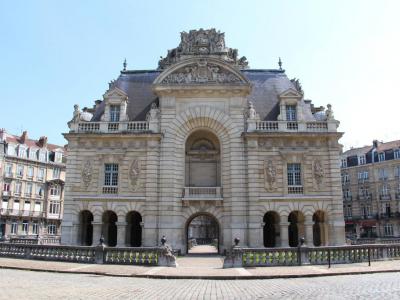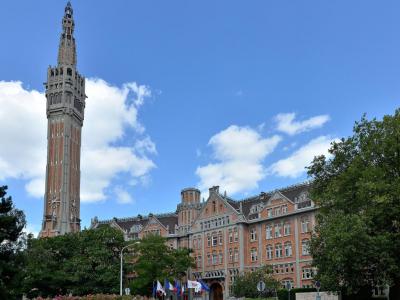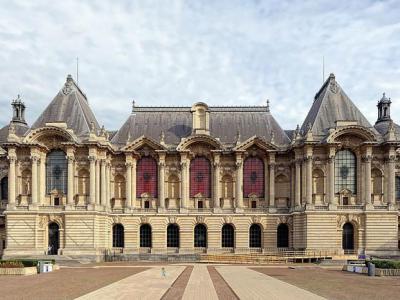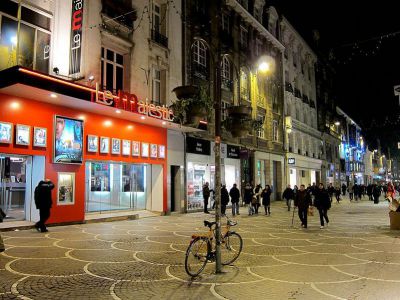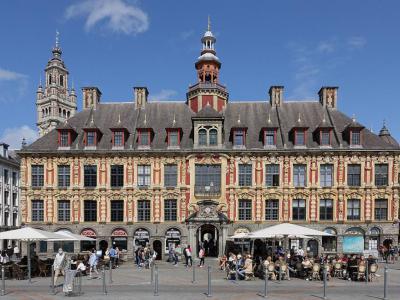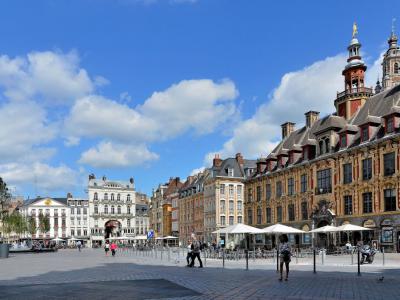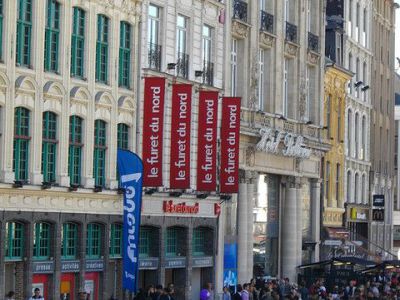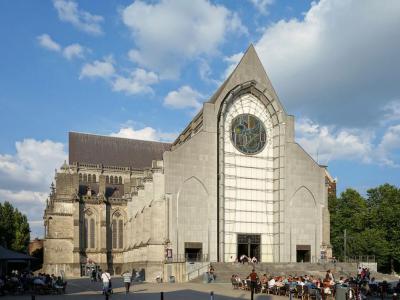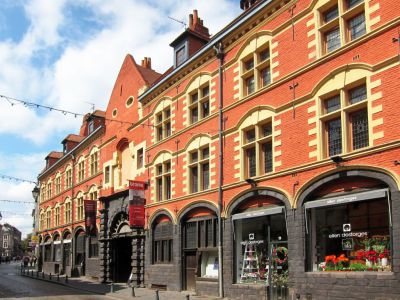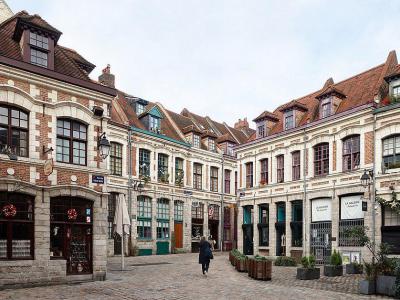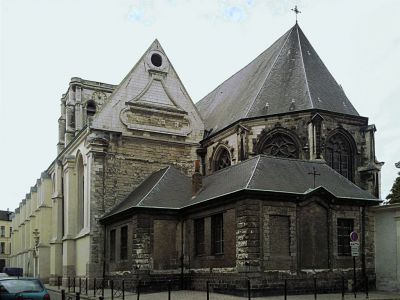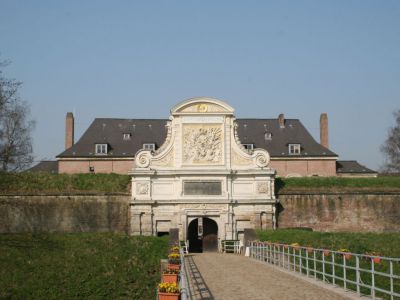
Lille Introduction Walking Tour (Self Guided), Lille
Nicknamed in France the "Capital of Flanders", Lille and its surroundings belong to the historical region of Romance Flanders. Legend has it that in 620 AD, Salvaert, Prince of Dijon, passed through the region with his pregnant wife when he was attacked and killed by the local lord Phinaert The Giant. Years later, his son Lyderic avenged his father by killing the Giant and founded the city of Lille, in 640 AD.
The name "Lille" stems from the Latin word "Insula," which means "island," alluding to the city's beginnings as an island amidst the marshes of the Deûle River.
A garrison town (as evidenced by its formidable Citadel), Lille has had an eventful history from the Middle Ages to the French Revolution. Very often besieged throughout the centuries, it belonged successively to the Burgundian State, the Holy Roman Empire of Germany, and the Spanish Netherlands. This was until in 1668 Lille was attached to the Kingdom of France under Louis XIV. The city again was under siege in 1792 during the Franco-Austrian War, and in 1914 and 1940, and was severely tested by the two world wars of the 20th century during which it was occupied and suffered destruction.
A merchant city since its origins and a manufacturing city since the 16th century, Lille emerged as a thriving hub during the Industrial Revolution centered around textile and mechanical production. The decline of the 1960s prompted a thorough conversion of the city in the 1990s giving it a totally new look.
The historic center of Lille, the Old Town, is characterized by its 17th-century red brick townhouses and paved pedestrian streets. The heart of Lille comes alive at the Main Square (Grande Place) surrounded by ornate buildings and the charming Ferrets of the North Bookstore (Librairie Furet du Nord), one of Europe's largest bookstores.
The belfry of the Lille City Hall (Hôtel de Ville de Lille) is classified as a UNESCO World Heritage Site.
Art enthusiasts will be enthralled by the Palace of Fine Arts (Palais des Beaux-Arts), boasting an impressive collection of European paintings, sculptures, and decorative arts.
Other major landmarks include the Lille Cathedral, a stunning Gothic masterpiece.
Lille effortlessly combines its storied past with modern vibrancy. By the grace of Eurostar and the TGV, it is now within easy reach of London, Paris, or Brussels. It can be done on a weekend, which will be unforgettable. So, why wait? Embark on your own adventure today and discover the enchanting world of Lille!
The name "Lille" stems from the Latin word "Insula," which means "island," alluding to the city's beginnings as an island amidst the marshes of the Deûle River.
A garrison town (as evidenced by its formidable Citadel), Lille has had an eventful history from the Middle Ages to the French Revolution. Very often besieged throughout the centuries, it belonged successively to the Burgundian State, the Holy Roman Empire of Germany, and the Spanish Netherlands. This was until in 1668 Lille was attached to the Kingdom of France under Louis XIV. The city again was under siege in 1792 during the Franco-Austrian War, and in 1914 and 1940, and was severely tested by the two world wars of the 20th century during which it was occupied and suffered destruction.
A merchant city since its origins and a manufacturing city since the 16th century, Lille emerged as a thriving hub during the Industrial Revolution centered around textile and mechanical production. The decline of the 1960s prompted a thorough conversion of the city in the 1990s giving it a totally new look.
The historic center of Lille, the Old Town, is characterized by its 17th-century red brick townhouses and paved pedestrian streets. The heart of Lille comes alive at the Main Square (Grande Place) surrounded by ornate buildings and the charming Ferrets of the North Bookstore (Librairie Furet du Nord), one of Europe's largest bookstores.
The belfry of the Lille City Hall (Hôtel de Ville de Lille) is classified as a UNESCO World Heritage Site.
Art enthusiasts will be enthralled by the Palace of Fine Arts (Palais des Beaux-Arts), boasting an impressive collection of European paintings, sculptures, and decorative arts.
Other major landmarks include the Lille Cathedral, a stunning Gothic masterpiece.
Lille effortlessly combines its storied past with modern vibrancy. By the grace of Eurostar and the TGV, it is now within easy reach of London, Paris, or Brussels. It can be done on a weekend, which will be unforgettable. So, why wait? Embark on your own adventure today and discover the enchanting world of Lille!
How it works: Download the app "GPSmyCity: Walks in 1K+ Cities" from Apple App Store or Google Play Store to your mobile phone or tablet. The app turns your mobile device into a personal tour guide and its built-in GPS navigation functions guide you from one tour stop to next. The app works offline, so no data plan is needed when traveling abroad.
Lille Introduction Walking Tour Map
Guide Name: Lille Introduction Walking Tour
Guide Location: France » Lille (See other walking tours in Lille)
Guide Type: Self-guided Walking Tour (Sightseeing)
# of Attractions: 12
Tour Duration: 2 Hour(s)
Travel Distance: 4.0 Km or 2.5 Miles
Author: rose
Sight(s) Featured in This Guide:
Guide Location: France » Lille (See other walking tours in Lille)
Guide Type: Self-guided Walking Tour (Sightseeing)
# of Attractions: 12
Tour Duration: 2 Hour(s)
Travel Distance: 4.0 Km or 2.5 Miles
Author: rose
Sight(s) Featured in This Guide:
- Porte de Paris (Paris Gate)
- Beffroi de l'Hôtel de ville de Lille (Belfry of Lille Town Hall Belfry)
- Palais des Beaux-Arts (Palace of Fine Arts)
- rue de Béthune (Bethune Street)
- Vieille Bourse (Old Stock Exchange)
- Grande Place (Main Square)
- Librairie Furet du Nord (Ferrets of the North Bookstore)
- Lille Cathedral
- Hospice Comtesse Museum
- Place aux Oignons (Onions Square)
- Église Sainte-Catherine (St. Catherine Church)
- Citadel of Lille
1) Porte de Paris (Paris Gate)
Louis XIV of France thought the dowry of his bride, Maria Theresa of Austria, wasn't paid. And furthermore, bits of Flanders controlled by Spain should be his. The result was the War of Devolution and the siege of Lille in 1668. Louis attacked, and in 18 days the city was his.
Louis entered the city in triumph. He paraded through the Gate of the Sick (Porte des Malades), and received the keys of the city from the Magistrate. Louis had plans for Lille and the Gate of the Sick.
Louis quickly commissioned architect Simon Vollant to build the Paris Gate. It was finished in 1692, a monument to Louis and the annexing of Lille. The Paris Gate was erected in front of a guardhouse built on the site of the Gate of the Sick. In 1860 the guardhouse was demolished along with the city fortifications.
In 1895 the Paris Gate was redeveloped by architect Louis-Marie Cordonnier. Monsieur Cordonnier created a facade on the city side and renovated the surrounding Simon-Vollant Square. The result is two different facades.
The Paris Gate is an Arch of Triumph. On top two angels proclaim the victory of Louis XIV. On the left is a sculpture of Mars, god of war. On the right, Hercules stands, a symbol of strength. Allegorical figures of "Fame" and "Victory" make ready to crown the King. A draw bridge at ground level leads to a vaulted hall that opens to the city.
Louis entered the city in triumph. He paraded through the Gate of the Sick (Porte des Malades), and received the keys of the city from the Magistrate. Louis had plans for Lille and the Gate of the Sick.
Louis quickly commissioned architect Simon Vollant to build the Paris Gate. It was finished in 1692, a monument to Louis and the annexing of Lille. The Paris Gate was erected in front of a guardhouse built on the site of the Gate of the Sick. In 1860 the guardhouse was demolished along with the city fortifications.
In 1895 the Paris Gate was redeveloped by architect Louis-Marie Cordonnier. Monsieur Cordonnier created a facade on the city side and renovated the surrounding Simon-Vollant Square. The result is two different facades.
The Paris Gate is an Arch of Triumph. On top two angels proclaim the victory of Louis XIV. On the left is a sculpture of Mars, god of war. On the right, Hercules stands, a symbol of strength. Allegorical figures of "Fame" and "Victory" make ready to crown the King. A draw bridge at ground level leads to a vaulted hall that opens to the city.
2) Beffroi de l'Hôtel de ville de Lille (Belfry of Lille Town Hall Belfry) (must see)
Has there ever been a belfry without bells? If no bells, why a belfry? That is a question for wiser heads. We know of a belfry with no bells. In Lille, France, the town hall belfry is the tallest municipal building in France and it has no bells.
The belfry tower was inaugurated in 1932. It is part of a reconstruction project to replace the old town hall, destroyed in World War I. It was built by architect Emile Dubuisson. Dubuisson was inspired to resonate his style with the traditional triangular gables of old Flemish houses.
The belfry is built of red bricks and concrete. It is slender and modernistic, attached to the stolid, grandiose town hall. They make a strange but harmonious ensemble. The city had previously three other bell towers. One was demolished in 1601. Another in 1856. The last came down in the Great War.
The current town hall and its tower were erected off-center, in the depressed Saint-Sauver district as a part of an urban renewal project of Socialist Mayor Gustave Delory.
The hall and the belfry show Classic Art-Deco and neo-Flemish elements common to the region. The tower utilizes a sculptured stone style of reinforced concrete. This allows for more strength. The belfry rises to a height of 338 feet. If you love heights, at the top there is a belvedere with nets. It is windy and high, an adventure!
The belfry tower was inaugurated in 1932. It is part of a reconstruction project to replace the old town hall, destroyed in World War I. It was built by architect Emile Dubuisson. Dubuisson was inspired to resonate his style with the traditional triangular gables of old Flemish houses.
The belfry is built of red bricks and concrete. It is slender and modernistic, attached to the stolid, grandiose town hall. They make a strange but harmonious ensemble. The city had previously three other bell towers. One was demolished in 1601. Another in 1856. The last came down in the Great War.
The current town hall and its tower were erected off-center, in the depressed Saint-Sauver district as a part of an urban renewal project of Socialist Mayor Gustave Delory.
The hall and the belfry show Classic Art-Deco and neo-Flemish elements common to the region. The tower utilizes a sculptured stone style of reinforced concrete. This allows for more strength. The belfry rises to a height of 338 feet. If you love heights, at the top there is a belvedere with nets. It is windy and high, an adventure!
3) Palais des Beaux-Arts (Palace of Fine Arts) (must see)
Facing the fountains enclosing the sculpture "Group Of Three" on the Republic Square, is the Palace of Fine Arts. On the other side of the square is the imposing limestone structure, the Prefecture of Lille.
The museum is a grandiose building made in a French end of century style of official architecture. It has elements of the Italian Renaissance with columns, pediments and a French roof. There are two domed pavilions on either side of the monumental façade. The façade is set off with moldings. The wings have loggias and balusters.
The original museum was established by Napoleon in 1801. The Emperor's decree selected 15 French cities to house art seized from churches and occupied lands. The new Museum was opened in 1892 and renovated extensively in 1997. The museum now has 71,500 square feet of exhibition space making it one of the largest museums in France.
The ground floor has military fortification models by Sebastien de Vauban, the famous military engineer of Louis XIV. Sebastien shares this space with 135 French sculptures. On the second floor (French first floor) is a collection of Flemish and Dutch paintings. There are 19th century French paintings from David to Toulouse-Lautrec.
The Museum possesses over 70,000 pieces of Art. The collection includes works by Raphael, Donatello, Van Dyck, Rembrandt, Goya, El Greco, Delacroix, Rubens, Rodin and Chardin, to mention a few.
The museum is a grandiose building made in a French end of century style of official architecture. It has elements of the Italian Renaissance with columns, pediments and a French roof. There are two domed pavilions on either side of the monumental façade. The façade is set off with moldings. The wings have loggias and balusters.
The original museum was established by Napoleon in 1801. The Emperor's decree selected 15 French cities to house art seized from churches and occupied lands. The new Museum was opened in 1892 and renovated extensively in 1997. The museum now has 71,500 square feet of exhibition space making it one of the largest museums in France.
The ground floor has military fortification models by Sebastien de Vauban, the famous military engineer of Louis XIV. Sebastien shares this space with 135 French sculptures. On the second floor (French first floor) is a collection of Flemish and Dutch paintings. There are 19th century French paintings from David to Toulouse-Lautrec.
The Museum possesses over 70,000 pieces of Art. The collection includes works by Raphael, Donatello, Van Dyck, Rembrandt, Goya, El Greco, Delacroix, Rubens, Rodin and Chardin, to mention a few.
4) rue de Béthune (Bethune Street)
Barely one hour from Paris by TGV train, Lille is a popular center for sightseeing and shopping. Among the shopping locations in central Lille, Bethune Street is a must-see street to visit.
Bethune Street is a pedestrianized street. Shopping is easier without dodging motorized shoppers. Bethune Street also connects with Sec Arembault Street and Bethune Square. Adjacent streets are Military Hospital Street (rue de l'Hopitale Militaire), Old Comedy Street (rue de la Vielle Comedie) and Tanners Street (rue des Tanneurs).
What can one get on Bethune Street? Let us count the ways. There is clothing and accessories for men, women and children, perfumery and cosmetics, all available at Mango, Lush, and Nocibe boutiques. There are two men's fashion stores and two women's stores. One-level mall type outlets and a store for geeks, nerds and gamers are here.
The Grand Scene is a food court offering "street food" and international snacks for a shopper's break. The street is busy in the day and very busy at night.
Bethune Street is a pedestrianized street. Shopping is easier without dodging motorized shoppers. Bethune Street also connects with Sec Arembault Street and Bethune Square. Adjacent streets are Military Hospital Street (rue de l'Hopitale Militaire), Old Comedy Street (rue de la Vielle Comedie) and Tanners Street (rue des Tanneurs).
What can one get on Bethune Street? Let us count the ways. There is clothing and accessories for men, women and children, perfumery and cosmetics, all available at Mango, Lush, and Nocibe boutiques. There are two men's fashion stores and two women's stores. One-level mall type outlets and a store for geeks, nerds and gamers are here.
The Grand Scene is a food court offering "street food" and international snacks for a shopper's break. The street is busy in the day and very busy at night.
5) Vieille Bourse (Old Stock Exchange) (must see)
Julien Destree was a master cabinet maker and architect in the city of Lille in 1651. The city had obtained from King Philip IV of Spain a license to build an exchange (bourse) for the merchants of the city. Julien Destree was the man to make it happen. He was determined to create a great monument to commerce to rival the one in Antwerp.
The King had authorized "an exchange...surrounded and encloses 24 houses." Twenty-four plots of land around the market square were sold to traders. Construction of the galleries, paving the courtyard and the four entrances were undertaken by the city. Construction took place under the direction of Julien Destree from 1652-1653.
The building shows a Renaissance Flemish influence prevalent in the 17th century. Piers and columns richly adorned with garlands and horns of plenty are a paen to the commerce of Lille. At the top of the bell tower stands a golden image of the god, Mercury. Lille was in fierce competition with her sister cities, Antwerp, Ghent, and Bruges.
In 1861 the stock exchange opened for business. It was a very modest exchange, not trading much more than 3% of its capital. In 1921 the new stock exchange building, the Chamber of Commerce, was opened. The Old Stock Exchange was indeed the "old" stock exchange.
The Old Stock Exchange is situated by the Main Square and the Theatre Square. It is an important landmark of the center of the city. It consists of a quadrangle of 24 look-alike houses surrounding a large courtyard. The courtyard today is a gathering venue for book stalls, florists, chess players, tourists and visitors.
The Old Stock Exchange can be reached by the Rihour metro station.
Why You Should Visit:
The old building sells a lot of things. Old books, coins, etc. The courtyard hosts games and bookstalls. The building itself is like a voyage back in time.
The King had authorized "an exchange...surrounded and encloses 24 houses." Twenty-four plots of land around the market square were sold to traders. Construction of the galleries, paving the courtyard and the four entrances were undertaken by the city. Construction took place under the direction of Julien Destree from 1652-1653.
The building shows a Renaissance Flemish influence prevalent in the 17th century. Piers and columns richly adorned with garlands and horns of plenty are a paen to the commerce of Lille. At the top of the bell tower stands a golden image of the god, Mercury. Lille was in fierce competition with her sister cities, Antwerp, Ghent, and Bruges.
In 1861 the stock exchange opened for business. It was a very modest exchange, not trading much more than 3% of its capital. In 1921 the new stock exchange building, the Chamber of Commerce, was opened. The Old Stock Exchange was indeed the "old" stock exchange.
The Old Stock Exchange is situated by the Main Square and the Theatre Square. It is an important landmark of the center of the city. It consists of a quadrangle of 24 look-alike houses surrounding a large courtyard. The courtyard today is a gathering venue for book stalls, florists, chess players, tourists and visitors.
The Old Stock Exchange can be reached by the Rihour metro station.
Why You Should Visit:
The old building sells a lot of things. Old books, coins, etc. The courtyard hosts games and bookstalls. The building itself is like a voyage back in time.
6) Grande Place (Main Square) (must see)
The Main Square of Lille was officially called "General de Gaulle Square" at the end of World War II. Among the good people of Lille however, it is often referred to as "The Main Square" As with New York, the Avenue of the Americas is "Sixth Avenue." Whatever it might be called, it is still the Main Square of the city.
In 1066 the area of the Main Square was referred to as the "forum." The forum was declared a market square. The ground was drained, leveled and paved and voila! A market square. In the 17th century, the Commodity Exchange divided the Square into the Main Square and the Little Square.
The Place du General-de-Gaulle assumes the role of Main Square. Oops, it is also referred to as "Place de la Decesse." Let us declare for Grand Place or Main Square. Today it is a venue for events and business exchanges. It is the traditional location for Lille book clearance sales, a major event.
The square is surrounded by a number of buildings. They include the Theatre of the North and the Old Stock Exchange (no longer the commercial exchange). In the center of the Main Square is the awesome "Column of the Goddess", memorializing the siege of Lille in 1792.
The square is paved in a checks of blue and pink granite. It is partially pedestrianized. It can be reached by metro first line Rihour station. There is also an underground car park with 342 spaces.
In 1066 the area of the Main Square was referred to as the "forum." The forum was declared a market square. The ground was drained, leveled and paved and voila! A market square. In the 17th century, the Commodity Exchange divided the Square into the Main Square and the Little Square.
The Place du General-de-Gaulle assumes the role of Main Square. Oops, it is also referred to as "Place de la Decesse." Let us declare for Grand Place or Main Square. Today it is a venue for events and business exchanges. It is the traditional location for Lille book clearance sales, a major event.
The square is surrounded by a number of buildings. They include the Theatre of the North and the Old Stock Exchange (no longer the commercial exchange). In the center of the Main Square is the awesome "Column of the Goddess", memorializing the siege of Lille in 1792.
The square is paved in a checks of blue and pink granite. It is partially pedestrianized. It can be reached by metro first line Rihour station. There is also an underground car park with 342 spaces.
7) Librairie Furet du Nord (Ferrets of the North Bookstore) (must see)
In 1936 a fur store on the Old Comedy Street (rue de la Vielle Comedie), pouff, became a bookstore. Georges Poulard, a high school principal, had bought the fur shop and opened the Ferrets of the North Bookstore. The fur store had the name Ferrets of the North. Georges kept the name, implying that book hunting was similar to hunting rabbits with ferrets.
Paul Callens worked at George Poulard's Ferrets of the North. Paul was obsessed with books. He bought the bookstore in 1947. He then heard the Galleries Barbes, a furniture store in the Main Square of lille, was closing. He moved the business to the Main Square location. The opening was in 1960 and it was a huge success.
Ferrets of the North was the largest bookstore in the world from 1992 to 1999. It is still the largest bookshop in Europe today.
In 1969 the facade of the Furet building in the Main Square was restored to its original 18th century style. The facade resonated with Francois Watteau's painting, "The Lille Procession in 1789". It worth going in there to take a look even if you are not looking for a new book.
Paul Callens worked at George Poulard's Ferrets of the North. Paul was obsessed with books. He bought the bookstore in 1947. He then heard the Galleries Barbes, a furniture store in the Main Square of lille, was closing. He moved the business to the Main Square location. The opening was in 1960 and it was a huge success.
Ferrets of the North was the largest bookstore in the world from 1992 to 1999. It is still the largest bookshop in Europe today.
In 1969 the facade of the Furet building in the Main Square was restored to its original 18th century style. The facade resonated with Francois Watteau's painting, "The Lille Procession in 1789". It worth going in there to take a look even if you are not looking for a new book.
8) Lille Cathedral (must see)
The miraculous statue of the Virgin Mary of the Trellis made its home in the Collegiate Church of Saint Peter from the 13th century until 1792. The gilded iron trellis wrapped around the statue was lost in the upheavals of the French Revolution. The statue was recovered and placed in the church of St Catherine, its iron trellis replaced with a wooden one.
In 1853 Charles-Kolb Bernard and his cousin formed a commission to build a fabulous new church in honor of Our Lady of the Treille. Land in the center of Lille was set aside for the construction. The 13th century Gothic styles shown by the cathedrals in Reims, Amiens and Chartres were pressed on the architects and builders.
At first the task was intimidating. It called for a building 433 feet long and spires reaching to 377 feet. The proportions were too large, the budget too small. The cathedral's main facade was not completed until the 1990s. The center is made of an ogive 96 feet high faced with 110 sheets of thick white marble.
A rose window dedicated to the Resurrection is by Ladislas Kijno. The main iron doorway was created by Georges Jeanclos. It is an enormous neo-Gothic building with a bold modern facade designed by architects Pierre-Louis Carlier and Peter Rice. In addition to services, the cathedral hosts concerts and it has a Sacred Art Center in its crypt.
The Cathedral is open all year. Guided tours are available.
In 1853 Charles-Kolb Bernard and his cousin formed a commission to build a fabulous new church in honor of Our Lady of the Treille. Land in the center of Lille was set aside for the construction. The 13th century Gothic styles shown by the cathedrals in Reims, Amiens and Chartres were pressed on the architects and builders.
At first the task was intimidating. It called for a building 433 feet long and spires reaching to 377 feet. The proportions were too large, the budget too small. The cathedral's main facade was not completed until the 1990s. The center is made of an ogive 96 feet high faced with 110 sheets of thick white marble.
A rose window dedicated to the Resurrection is by Ladislas Kijno. The main iron doorway was created by Georges Jeanclos. It is an enormous neo-Gothic building with a bold modern facade designed by architects Pierre-Louis Carlier and Peter Rice. In addition to services, the cathedral hosts concerts and it has a Sacred Art Center in its crypt.
The Cathedral is open all year. Guided tours are available.
9) Hospice Comtesse Museum
In the middle of the old town of Lille, on the cobbled street, Money Street (rue de la Monnaie), there is a museum like no other. Behind imposing wooden doors is the Hospice Comtesse Museum. Pass through the doors and discover a museum consisting of different buildings and courtyards laid out like a medieval convent.
The museum was once a hospital founded in 1237 by Jeanne, Comtesse of Flanders. The Comtesse established the hospital within her own palace walls. The mission of the hospital was to care for the sick and the poor and to be a haven for pilgrims on their way to Rome and Compostela. It fulfilled its mission until 1939.
The museum is made up of buildings dating from the 15th, 17th and 18th centuries. There is a former hospital ward with a paneled vault ceiling. The chapel is adorned with the coats-of-arms of titled donors. Other buildings belonged to a community of Augustine nuns. All were arranged around a couple of courtyards and a garden of medicinal herbs.
Since 1962 the building has operated as museum. The collections include paintings, wood sculptures, tapestries and porcelain drawn from the area. The overall ambience is of a Flemish convent of the 1600s.
The museum was once a hospital founded in 1237 by Jeanne, Comtesse of Flanders. The Comtesse established the hospital within her own palace walls. The mission of the hospital was to care for the sick and the poor and to be a haven for pilgrims on their way to Rome and Compostela. It fulfilled its mission until 1939.
The museum is made up of buildings dating from the 15th, 17th and 18th centuries. There is a former hospital ward with a paneled vault ceiling. The chapel is adorned with the coats-of-arms of titled donors. Other buildings belonged to a community of Augustine nuns. All were arranged around a couple of courtyards and a garden of medicinal herbs.
Since 1962 the building has operated as museum. The collections include paintings, wood sculptures, tapestries and porcelain drawn from the area. The overall ambience is of a Flemish convent of the 1600s.
10) Place aux Oignons (Onions Square)
Looking for onions? You won't necessarily find a sack of onions in Onions Square. The site of the square once held the fortress of the counts of Flanders. In the fortress was a keep, a strong place, called dominium. That is all gone now, but the locals corrupted the word, dominium, into "Ognions."
The square is lined with houses dating from the 17th and 18th centuries. The houses on the square originally were homes for artisan weavers. The weavers used the attics and cellars as workshops if conditions of humidity were acceptable. In the eighteenth century the houses became living quarters for factory workers and their families.
The neighborhood was not known for its sanitation or habitability. In 1945, George d'Orgeville, a novelist, described the square as a "district of misfortune...lined with hovels which are falling apart..." Living conditions were deplorable by today's standards. Six or seven families were often sharing one water tap and a toilet.
Buildings were dilapidated. In 1976 reinforcing work was begun prior to restoration. Between 1985 and 1990 all buildings on the square were partially or completely rebuilt. Since the year 2000, the square has become a draw for tourists. The square is now a pedestrian area surrounded by restaurants and cafes.
The square is lined with houses dating from the 17th and 18th centuries. The houses on the square originally were homes for artisan weavers. The weavers used the attics and cellars as workshops if conditions of humidity were acceptable. In the eighteenth century the houses became living quarters for factory workers and their families.
The neighborhood was not known for its sanitation or habitability. In 1945, George d'Orgeville, a novelist, described the square as a "district of misfortune...lined with hovels which are falling apart..." Living conditions were deplorable by today's standards. Six or seven families were often sharing one water tap and a toilet.
Buildings were dilapidated. In 1976 reinforcing work was begun prior to restoration. Between 1985 and 1990 all buildings on the square were partially or completely rebuilt. Since the year 2000, the square has become a draw for tourists. The square is now a pedestrian area surrounded by restaurants and cafes.
11) Église Sainte-Catherine (St. Catherine Church)
In the center of the Old Lille district is Saint Catherine Church, dedicated to Saint Catherine of Alexandria. It was built in the thirteenth century. It is constructed as a "Hallekerk", a church laid out like a hall in the old Flemish tradition. It is the oldest parish church in the city.
Although it appears in a lush Gothic style, it is all on one level with three naves and one transept. The bell tower is squat and stolid. It is a dominating figure and it holds the oldest bell in the city. The tower served as an optical telegraph station in the 18th century. On the north wall were reclusoirs, cells for pious meditation.
Inside the church there is much to admire. There is carved wooden furniture from the 1800s and paintings of Saint Mathieu, Saint John the Evangelist, and Saints Mark and Luke by artist Victor Mottez. Most admirable is the stained glass window showing the Triumph of Saint Catherine and the paneled cradles of the ceiling.
The church was classified as an Historical Monument in August 1991.
Although it appears in a lush Gothic style, it is all on one level with three naves and one transept. The bell tower is squat and stolid. It is a dominating figure and it holds the oldest bell in the city. The tower served as an optical telegraph station in the 18th century. On the north wall were reclusoirs, cells for pious meditation.
Inside the church there is much to admire. There is carved wooden furniture from the 1800s and paintings of Saint Mathieu, Saint John the Evangelist, and Saints Mark and Luke by artist Victor Mottez. Most admirable is the stained glass window showing the Triumph of Saint Catherine and the paneled cradles of the ceiling.
The church was classified as an Historical Monument in August 1991.
12) Citadel of Lille (must see)
King Louis XIV captured Lille from Spanish occupation in 1668. Shortly after marching in triumph through the Gate of the Sick, Louis commissioned his military engineer and architect, Paul Vauban, to fortify the city and the border between France and Flanders. The Citadel of Lille, the "Queen of Citadels" was Vauban's creation.
The citadel was the lynch pin to a complex of fortifications also designed by Vauban which firmly secured France's northern corner against invasion. Vauban established a double line of 28 fortified cities in this defense complex. The double line extended between Gravelines, Dunkirk and Maubeuge-Rocoi.
The citadel was situated on marshland between the rivers Delle and Bucquet. With a system of locks and gates the surrounding areas around the citadel could be flooded without warning. The fort is made in the form of a pentagon. The pentagon in turn is further defended by outer walls. This design was present in all Vauban's military works.
Several elements and components of the Citadel have been classified as historic monuments in 1914, 1921 and 1934.
The citadel was the lynch pin to a complex of fortifications also designed by Vauban which firmly secured France's northern corner against invasion. Vauban established a double line of 28 fortified cities in this defense complex. The double line extended between Gravelines, Dunkirk and Maubeuge-Rocoi.
The citadel was situated on marshland between the rivers Delle and Bucquet. With a system of locks and gates the surrounding areas around the citadel could be flooded without warning. The fort is made in the form of a pentagon. The pentagon in turn is further defended by outer walls. This design was present in all Vauban's military works.
Several elements and components of the Citadel have been classified as historic monuments in 1914, 1921 and 1934.
Walking Tours in Lille, France
Create Your Own Walk in Lille
Creating your own self-guided walk in Lille is easy and fun. Choose the city attractions that you want to see and a walk route map will be created just for you. You can even set your hotel as the start point of the walk.
Lille's Historical Buildings Tour
Historically, Lille's architecture differs from that of other French cities. Prior to being invaded by Louis XIV in 1667, Lille was Flemish, which is evident in its red-brick and other structures, quite uncommon for the rest of France.
Among many things, Lille is reputed for its fabulous historic center, abounding in time-honored buildings, palaces, and churches, offering a great deal of... view more
Tour Duration: 2 Hour(s)
Travel Distance: 3.7 Km or 2.3 Miles
Among many things, Lille is reputed for its fabulous historic center, abounding in time-honored buildings, palaces, and churches, offering a great deal of... view more
Tour Duration: 2 Hour(s)
Travel Distance: 3.7 Km or 2.3 Miles
The Most Popular Cities
/ view all
